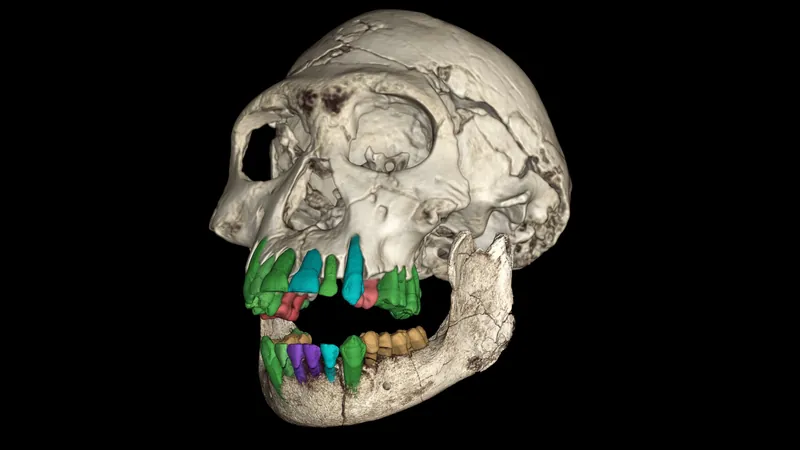
Unlocking the Secrets of Ancient Earth: How a Hostile Atmosphere Gave Way to Life
2024-11-13
Author: Li
Introduction
Will we ever uncover the mysteries of how life began on Earth? Our planet's multi-billion-year history paints a fascinating narrative, yet the evolution of its atmospheric chemistry remains somewhat elusive. At one point, Earth was a harsh, inhospitable world, and its fascinating transition to a life-rich environment is the topic of intense scientific inquiry.
Earth's Unique Atmospheric Evolution
What sets Earth apart from its neighboring planets? Interestingly, research reveals that in its distant past, Earth bore similarities to modern-day Venus and Mars in terms of atmospheric makeup. So, what catalyzed such a drastic divergence in planetary evolution?
The Importance of Atmospheric Transformation
Understanding Earth's atmospheric transformation is not just about painting a historical picture; it offers vital insights into the atmospheres of distant exoplanets that scientists are currently evaluating. With advanced telescopes set to reveal more atmospheric complexities in exoplanets shortly, the ancient mysteries of Earth's atmosphere may hold the keys to these distant worlds.
The Early Reducing Atmosphere
In its early days, Earth possessed a reducing atmosphere, characterized by a scarcity of free oxygen. Instead, it was rich in gases like hydrogen and methane, which not only reacted with oxygen but also engaged in chemical reactions when exposed to ultraviolet (UV) light, eventually leading to the formation of organic molecules crucial for life.
Groundbreaking Research Study
Researchers from Tohoku University, the University of Tokyo, and Hokkaido University have embarked on a groundbreaking study, unveiling a new model of atmospheric chemical reactions from ancient Earth. Tatsuya Yoshida, the lead author, explains in the journal *Astrobiology* that this research, titled “Self-Shielding Enhanced Organics Synthesis in an Early Reduced Earth’s Atmosphere,” provides insights into the atmospheric dynamics that may have paved the way for the emergence of the first living organisms.
Essential Prebiotic Molecules
Before life could arise, Earth needed essential prebiotic molecules like formaldehyde (H2CO) and hydrogen cyanide (HCN). These molecules are fundamental because they can react in numerous ways to form amino acids, sugars, and nucleobases—the building blocks of DNA and RNA.
Primordial Oceans and Chemical Evolution
A key finding from the study suggests that an early reduced atmosphere, especially when situated above primordial oceans, was a likely environment for synthesizing these vital prebiotic compounds. Not only was the primordial ocean drastically different from today's oceans—being hot and acidic due to volcanic activity—but it also played a crucial role in the chemical evolution of the planet.
Description of the Ancient Environment
Describing the ancient environment, co-author Shungo Koyama of Tohoku University mentions, “Ancient Earth was nothing like our current home; it was a much more hostile place, rich in metallic iron and gases like hydrogen and methane.”
The Role of UV Radiation
Without the protection of an ozone layer, intense UV radiation from the early Sun bombarded the planet, driving reactions across its atmosphere, oceans, and crust.
Ongoing Mysteries
While we have a broad understanding of these events, numerous details remain unknown. The complex interplay between the formation of organic matter and its subsequent oxidation is still a mystery that needs unraveling.
The Comprehensive Photochemical Model
The researchers created a comprehensive photochemical model for the ancient reduced atmosphere, which primarily comprised hydrogen (H2) and methane (CH4). Drawing from proven models of other planetary atmospheres—like Jupiter and ancient Mars—the study calculated the dynamics of 342 separate chemical reactions, including how atmospheric mixing and hydrogen escape influenced this catalytic environment.
Impact of Young Sun on Chemical Processes
It's noteworthy that the young Sun emitted more robust UV radiation than we experience today, leading to the breakdown of water molecules into reactive radicals. These radicals drove chemical processes that ultimately produced organic compounds like HCN and H2CO in significant quantities.
The Role of Hydrocarbons
Hydrocarbons such as acetylene (C2H2) also played a pivotal role, absorbing UV radiation and thus shielding the lower atmosphere from further breakdown. This unique interaction promoted the buildup of organic molecules—a primordial soup ripe for the inception of life.
Formation of Organic Compounds
The findings suggest that nearly half of the initial methane converted into heavier organics over geological time scales, which could have propelled the genesis of the first amino acids, nucleobases, and sugars essential for life.
Continuous Synthesis of Prebiotic Molecules
As the reduced atmosphere evolved, continuous synthesis of H2CO and HCN occurred, indicating that Earth’s early atmosphere itself was a potent incubator for these prebiotic molecules—eliminating the assumption that they primarily originated from meteorites or comets.
An Abundant Layer of Organics
In an astonishing twist, the calculations indicate the formation of a vast layer of organics—potentially several hundred meters thick—covering the primordial ocean. This constant influx of essential prebiotic molecules might have contributed to the rich mixture of materials from which life ultimately sprang.
Significance of the Research
Yoshida notes the significance of this research, pondering, "There may have been an accumulation of organics that created what was like an enriched soup of important building blocks—this could be where living things first emerged on Earth."
Conclusion and Future Implications
Though this research doesn’t provide all the answers, it significantly enhances our understanding of the evolutionary path Earth has taken. The compelling questions linger: Is Earth unique in its development, or could there be a common trajectory that exoplanets in distant solar systems may follow? Scientists strive to crack these codes, perhaps leading us towards unraveling the nature of life beyond our planet.




 Brasil (PT)
Brasil (PT)
 Canada (EN)
Canada (EN)
 Chile (ES)
Chile (ES)
 España (ES)
España (ES)
 France (FR)
France (FR)
 Hong Kong (EN)
Hong Kong (EN)
 Italia (IT)
Italia (IT)
 日本 (JA)
日本 (JA)
 Magyarország (HU)
Magyarország (HU)
 Norge (NO)
Norge (NO)
 Polska (PL)
Polska (PL)
 Schweiz (DE)
Schweiz (DE)
 Singapore (EN)
Singapore (EN)
 Sverige (SV)
Sverige (SV)
 Suomi (FI)
Suomi (FI)
 Türkiye (TR)
Türkiye (TR)